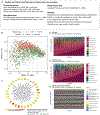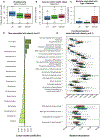Obese Individuals with and without Type 2 Diabetes Show Different Gut Microbial Functional Capacity and Composition
- PMID: 31399369
- PMCID: PMC7720933
- DOI: 10.1016/j.chom.2019.07.004
Obese Individuals with and without Type 2 Diabetes Show Different Gut Microbial Functional Capacity and Composition
Abstract
Obesity and type 2 diabetes (T2D) are metabolic disorders that are linked to microbiome alterations. However, their co-occurrence poses challenges in disentangling microbial features unique to each condition. We analyzed gut microbiomes of lean non-diabetic (n = 633), obese non-diabetic (n = 494), and obese individuals with T2D (n = 153) from German population and metabolic disease cohorts. Microbial taxonomic and functional profiles were analyzed along with medical histories, serum metabolomics, biometrics, and dietary data. Obesity was associated with alterations in microbiome composition, individual taxa, and functions with notable changes in Akkermansia, Faecalibacterium, Oscillibacter, and Alistipes, as well as in serum metabolites that correlated with gut microbial patterns. However, microbiome associations were modest for T2D, with nominal increases in Escherichia/Shigella. Medications, including antihypertensives and antidiabetics, along with dietary supplements including iron, were significantly associated with microbiome variation. These results differentiate microbial components of these interrelated metabolic diseases and identify dietary and medication exposures to consider in future studies.
Keywords: dietary supplements; iron; magnesium; medication; metabolic disease; microbiome; nutrition; obesity; type 2 diabetes.
Copyright © 2019. Published by Elsevier Inc.
Conflict of interest statement
DECLARATION OF INTERESTS
L.B.T. is an employee and shareholder of BiomCare. C.H. is a scientific advisor for Seres Therapeutics, microbiome Insights, and ZOE.
Figures




Comment in
-
Variations in microbial composition and function in metabolic diseases.Nat Rev Endocrinol. 2019 Oct;15(10):563. doi: 10.1038/s41574-019-0253-z. Nat Rev Endocrinol. 2019. PMID: 31417192 No abstract available.
Similar articles
-
Roux-en-Y gastric bypass surgery of morbidly obese patients induces swift and persistent changes of the individual gut microbiota.Genome Med. 2016 Jun 15;8(1):67. doi: 10.1186/s13073-016-0312-1. Genome Med. 2016. PMID: 27306058 Free PMC article. Clinical Trial.
-
Understanding the Role of the Gut Microbiome and Microbial Metabolites in Obesity and Obesity-Associated Metabolic Disorders: Current Evidence and Perspectives.Curr Obes Rep. 2019 Sep;8(3):317-332. doi: 10.1007/s13679-019-00352-2. Curr Obes Rep. 2019. PMID: 31175629 Review.
-
Tailored impact of dietary fibers on gut microbiota: a multi-omics comparison on the lean and obese microbial communities.Microbiome. 2024 Nov 30;12(1):250. doi: 10.1186/s40168-024-01975-x. Microbiome. 2024. PMID: 39616358 Free PMC article.
-
Microbial co-occurrence complicates associations of gut microbiome with US immigration, dietary intake and obesity.Genome Biol. 2021 Dec 10;22(1):336. doi: 10.1186/s13059-021-02559-w. Genome Biol. 2021. PMID: 34893089 Free PMC article.
-
Gut microbiome and type 2 diabetes: where we are and where to go?J Nutr Biochem. 2019 Jan;63:101-108. doi: 10.1016/j.jnutbio.2018.10.003. Epub 2018 Oct 11. J Nutr Biochem. 2019. PMID: 30366260 Review.
Cited by
-
Characteristics of the gut microbiome in patients with prediabetes and type 2 diabetes.PeerJ. 2021 Mar 24;9:e10952. doi: 10.7717/peerj.10952. eCollection 2021. PeerJ. 2021. PMID: 33828910 Free PMC article.
-
Perspective: Nutritional Strategies Targeting the Gut Microbiome to Mitigate COVID-19 Outcomes.Adv Nutr. 2021 Jul 30;12(4):1074-1086. doi: 10.1093/advances/nmab031. Adv Nutr. 2021. PMID: 33783468 Free PMC article. Review.
-
The gut peptide Reg3g links the small intestine microbiome to the regulation of energy balance, glucose levels, and gut function.Cell Metab. 2022 Nov 1;34(11):1765-1778.e6. doi: 10.1016/j.cmet.2022.09.024. Epub 2022 Oct 13. Cell Metab. 2022. PMID: 36240758 Free PMC article.
-
Unraveling Gut Microbiota Signatures Associated with PPARD and PARGC1A Genetic Polymorphisms in a Healthy Population.Genes (Basel). 2022 Feb 1;13(2):289. doi: 10.3390/genes13020289. Genes (Basel). 2022. PMID: 35205333 Free PMC article.
-
Potential of multiomics technology in precision medicine.Curr Opin Gastroenterol. 2019 Nov;35(6):491-498. doi: 10.1097/MOG.0000000000000589. Curr Opin Gastroenterol. 2019. PMID: 31464810 Free PMC article. Review.
References
Publication types
MeSH terms
Substances
Grants and funding
LinkOut - more resources
Full Text Sources
Other Literature Sources
Medical

